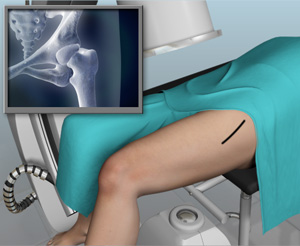
Medical conditions such as arthritis can damage or wear out the articular cartilage covering the hip joint surface and cause inflammation and severe pain in the hip. The condition can be treated by replacing the hip joint through surgery.
What is Direct Anterior Approach Hip Replacement Surgery?
Direct anterior hip replacement is a minimally invasive hip surgery to replace the hip joint without cutting through any muscles or tendons as against traditional hip replacement that involves cutting major muscles to access the hip joint. X-ray guidance involves the use of pre-operative radiographic studies to help select the right size of the implant. In surgery, a special live x-ray is used to determine the proper position in which the implant should be placed.
Advantages of Anterior Hip Replacement
The advantages of anterior hip replacement include:
- Smaller incisions
- Shorter operative time
- Minimal blood loss
- Home same day or overnight hospital stay
- Less postoperative pain
- Minimal soft-tissue trauma
- Less scarring
- Quicker recovery
- Early mobilization
- Less postoperative restrictions
- Quicker return to normal activities
- Lower risk of dislocation
Benefits of X-ray guided hip replacement include:
- Live visual guidance to match patient’s specific anatomy
- Minimizes leg-length differences
- Improves hip biomechanics
- Increases implant longevity
- Decreases risk of dislocation of the prosthesis
Anterior Hip Replacement Procedure
Anterior hip replacement surgery is performed under general anesthesia or spinal anesthesia. You will lie down on your back, on a special operating table that enables your surgeon to perform the surgery from the front of the hip. Dr Ehmke will use fluoroscopic x-ray imaging during the surgery to ensure the accuracy of component positioning and to minimize leg length inequality.
Your surgeon will make an incision, about 4 inches long on the front of the hip. The muscles are pushed aside to gain access to the joint and perform the replacement. Next, the femur is separated from the acetabular socket. The acetabular surface is prepared using a special instrument called a reamer. The acetabular component is then placed into the socket under guidance of x-ray to make sure it is in proper position. Then, a liner made up of plastic, metal, or ceramic is placed inside the acetabular component.
The femoral head that is worn out is cut off and the femur is prepared using special instruments so that the new metal component fits the bone properly. Then, the new femoral component is inserted into the femur. This is again done with guidance of x-ray to make sure the proper size is chosen and the length of the legs match up. The femoral head component made of ceramic or metal is then placed on the femoral stem.
Once the artificial components are fixed in place, the instruments are withdrawn and incisions are closed with dissolvable and glue to cover it.
Risks and Complications of Anterior Hip Replacement
All surgeries carry an element of risk, whether it is related to the anesthesia or the procedure itself. Risks and complications with anterior hip replacement are rare, but can occur and may include:
- Infection at the incision site or joint space
- Fracture
- Nerve damage
- Hemarthrosis - excess bleeding into the joint after the surgery
- Deep vein thrombosis (blood clot)
- Leg length inequality
Post-operative Care for Anterior Hip Replacement
After the surgery, you will be moved to the recovery room where you will be under observation for a few hours. A physical therapist will have you walk with them and provide instructions to help you with sitting, standing and doing stairs. You will also be given a daily exercise program that will help speed up your recovery. Most patients take about 4-6 weeks to walk without any assistance and to engage in their normal activities of daily living.
With the anterior approach, your doctor will give you specific instructions to be followed at home for a faster recovery. These include:
- Take medications as prescribed to relieve pain and prevent infection.
- Participate in physical therapy to restore hip function and strength.
- Eat a healthy diet and do not smoke to facilitate healing and promote a faster recovery.
- Contact your doctor if you observe increasing swelling or redness in the operated area.




